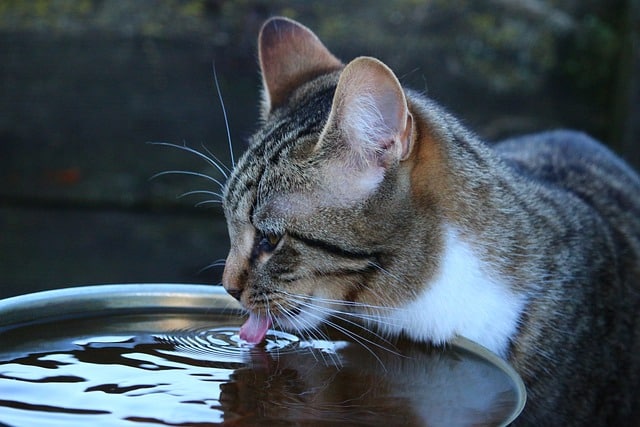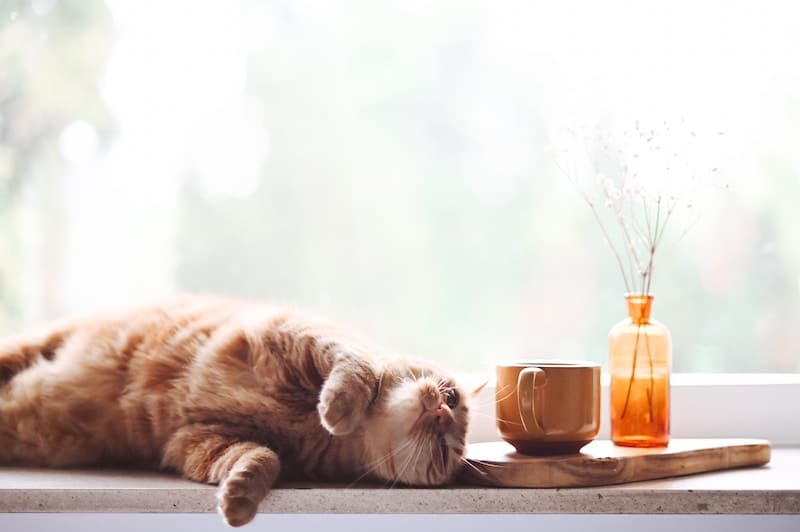When a cat’s urine is too acidic, it is said to have a high pH. This condition can be caused by various factors, including mineral deposits and crystals in the urine. Additionally, Feline lower urinary tract disease is a common condition that can result in high pH levels in cats.
If you suspect that your cat has a high pH level, it is important to take prompt action to ensure that your pet receives the appropriate care and treatment. This may involve changes in diet, increased hydration, and medications prescribed by a veterinarian.
It’s worth noting that high pH levels alone may not be indicative of a serious underlying condition, but it is always best to seek professional guidance. By doing so, you can ensure that your feline friend remains healthy, happy, and comfortable. So, if you’re wondering why your cat has a high pH level, don’t hesitate to reach out to a trusted veterinarian for help.
Reasons for a High PH in Cats
Diet
Diet is one of the most common factors that can contribute to a high pH level in cats. In particular, cats that consume diets that are high in grains, carbohydrates, and vegetables are at risk of developing a high pH in their urine. This is because these types of foods tend to alkalinize the urine and increase its pH level.
Cats are obligate carnivores, which means that they require a high-protein diet that is low in carbohydrates. When a cat consumes too many carbohydrates, their body converts the excess into glucose and glycogen, which can increase the pH level of the urine. Additionally, diets that are high in carbohydrates can cause dehydration in cats, which can further exacerbate high pH levels.
One way to prevent high pH levels in cats is to ensure that their diet is properly balanced and contains the appropriate amount of protein and moisture. Many commercial cat foods are formulated to meet the nutritional needs of cats, but it’s always a good idea to read the label and ensure that the ingredients are of high quality.
Dehydration

Dehydration is another common cause of high pH levels in cats. When a cat does not consume enough water, their urine becomes more concentrated, leading to an increase in its pH level. This can be particularly concerning in cats, as their urinary tract is more susceptible to developing issues like urinary tract infections and bladder stones when their urine is too concentrated.
There are several factors that can contribute to dehydration in cats. These include not drinking enough water, excessive urination, and certain medical conditions such as kidney disease. Additionally, some cats are simply picky drinkers and may not consume enough water to maintain healthy hydration levels.
To prevent dehydration in cats, it’s important to encourage them to drink water regularly. This can be done by providing fresh, clean water in a bowl that is easily accessible to your cat. Some cats prefer running water, so a cat fountain or dripping faucet may be a good option. Wet cat food can also help increase your cat’s hydration levels, as it contains moisture that can contribute to overall hydration.
Strucvite crystals
Struvite crystals are another common cause of high pH levels in cats. Struvite crystals are mineral deposits that can form in the urinary tract, particularly when the urine is too alkaline (high pH) or when there are high levels of magnesium, ammonia, and phosphates in the urine. These crystals can cause a range of issues, including urinary tract infections, blockages, and inflammation.
Struvite crystals are more common in female cats and cats that are overweight or inactive. Additionally, diets that are high in magnesium and phosphates may increase the risk of struvite crystal formation.
To prevent struvite crystals in cats, it’s important to encourage a healthy urinary tract. This can be done by providing fresh, clean water and ensuring that your cat’s litter box is clean and easily accessible. Additionally, feeding a high-quality diet that is low in magnesium and phosphates can help reduce the risk of struvite crystal formation.
Kidney disease

Kidney disease is a serious medical condition that can lead to a high pH level in cats. The kidneys play a critical role in regulating the body’s pH balance by excreting excess acids or bases. When the kidneys are not functioning properly, the body may become more acidic, leading to an increase in the pH level of the urine.
There are several different types of kidney disease that can affect cats, including acute kidney injury, chronic kidney disease, and polycystic kidney disease. These conditions can cause a range of symptoms, including increased thirst and urination, vomiting, and weight loss. In some cases, kidney disease may not cause any noticeable symptoms until it has progressed to an advanced stage.
To prevent kidney disease in cats, it’s important to maintain good overall health. This can be done by providing a high-quality diet that is appropriate for your cat’s age and lifestyle, ensuring that your cat stays hydrated, and scheduling regular veterinary check-ups to catch any potential issues early on.
Feline lower urinary tract disease
Urinary tract infections (UTIs) are a common cause of high pH levels in cats. A UTI occurs when bacteria enter the urinary tract and cause an infection, leading to inflammation and irritation of the bladder and urinary tract. UTIs can increase the pH level of the urine and cause other symptoms such as frequent urination, straining to urinate, and blood in the urine.
UTIs can affect cats of all ages and breeds, but they are more common in female cats and cats with underlying medical conditions such as diabetes or kidney disease. Additionally, cats with weakened immune systems or those that are stressed may be more susceptible to developing UTIs.
To prevent UTIs in cats, it’s important to encourage good urinary tract health. This can be done by providing fresh, clean water, ensuring that your cat’s litter box is clean and easily accessible, and feeding a high-quality diet that meets their nutritional needs. Additionally, minimizing stress in your cat’s environment can help reduce their risk of developing a UTI.
If you suspect that your cat has a UTI, it’s important to seek veterinary care promptly. UTIs can be uncomfortable and even painful for your cat, and if left untreated, they can lead to serious complications. Your veterinarian may recommend antibiotics or other treatments to help clear the infection and prevent future UTIs from occurring. Additionally, they may recommend changes to your cat’s diet or lifestyle to promote good urinary tract health and prevent future high pH levels.
Infection
Infections in the urinary tract can also be a cause of high pH levels in cats. Urinary tract infections (UTIs) are caused by bacteria that enter the urinary tract and cause inflammation and irritation. This can lead to changes in the pH level of the urine, making it more alkaline.
Some common signs of a urinary tract infection in cats include increased frequency of urination, straining to urinate, blood in the urine, and excessive licking of the genital area. If you suspect your cat has a urinary tract infection, it’s important to seek veterinary care right away. UTIs can be uncomfortable for your cat and can lead to more serious health issues if left untreated.
Your veterinarian may perform a urinalysis to determine the pH level of your cat’s urine and check for the presence of bacteria or other abnormalities. If a UTI is confirmed, your cat may be prescribed antibiotics or other medications to help clear the infection. Additionally, your veterinarian may recommend dietary changes and other management strategies to help prevent future infections and maintain a healthy urinary tract.
How do you treat a high PH in cats?

First of all, your vet will likely take a urine sample and check it for any signs of infection. If an infection is found, the vet will prescribe antibiotics to treat it. In some cases, the vet may also recommend a special diet to help lower your cat’s pH levels.
Your vet will be able to run some tests to make sure the cause of the issue is not urinary crystals, kidney disease or some other disorder.
Your vet may also recommend that you give your cat supplements to help regulate its pH levels. These can include probiotics or other supplements that can help to balance the acidity in your cat’s urine.
In addition to supplements, you should also make sure your cat is drinking plenty of water. This will help to flush out any toxins in the urine and keep the pH levels balanced.
Finally, it is important to keep an eye on your cat’s diet. Make sure you are feeding it a balanced diet that is low in acidity. This will help to keep your cat’s pH levels in check and prevent further complications.
High pH levels in cats can be a sign of a serious underlying health problem. It is important to take your cat to the vet to identify the cause and treat it accordingly. With the right treatment, you can help your cat maintain healthy pH levels and keep it healthy for years to come.
Keeping your cat well hydrated
Keeping your cat well hydrated is important to help avoid any type of urinary tract problem. The average healthy adult cat should drink between 3.5 and 4.5 ounces of water per day.
While many domestic cats don’t drink enough, there are a few ways you can get your cat to drink more.
The most obvious way to encourage your cat to drink is to make sure there is a water bowl available at all times. If you have more than one cat, it is best to give them access to water in different rooms in the house.
Keeping your cat well hydrated also involves keeping them away from harmful substances. These can be things like coffee, tea, and pesticides. If your cat is experiencing symptoms of dehydration, it is a good idea to contact your vet to get them checked out.
FAQs: My cat has a high PH
High alkaline in cat litter can be a confusing topic for cat owners. Luckily, Pretty Litter is here to help. Pretty Litter is a revolutionary cat litter that’s designed to help keep your cat’s litter box clean and healthy. It’s also designed to help monitor your cat’s health by changing color when it detects changes in your cat’s pH level.
Pretty Litter is made of silica gel crystals, which are naturally alkaline. These crystals act as a buffer to help maintain a healthy pH level in your cat’s litter box. When your cat eliminates in the litter box, the resulting waste is usually acidic. This can cause the litter to become more acidic, which can lead to an unhealthy environment for your cat.
Pretty Litter’s alkaline crystals help to keep the pH level in the litter box balanced, creating an environment that’s healthy for your cat. The alkaline crystals also help to neutralize the odor of your cat’s waste, making it more bearable for you and your cat.
Pretty Litter’s alkaline crystals are designed to last up to 30 days. This means that you can go longer between litter box changes, which can save you both time and money. Plus, it’s more convenient for you and your cat because you don’t have to worry about changing the litter as often.
So if you’re looking for a cat litter that’s designed to help keep your cat’s litter box clean and healthy, Pretty Litter is the perfect choice. With its high alkaline crystals, Pretty Litter can help create a healthy environment for your cat and make it easier for you to maintain a clean litter box.
A high pH in cats refers to an abnormally high level of alkalinity in their urine, which can lead to a range of health issues. A cat’s urine pH is typically around 6.0-6.5, which is slightly acidic. However, if the pH level rises above 7.0, it is considered to be high or alkaline.
High pH levels in cats can be caused by a variety of factors, including diet, dehydration, urinary tract infections, kidney disease, and the presence of struvite crystals in the urine. It’s important to monitor your cat’s urinary tract health and seek veterinary care if you notice any changes in their urinary habits or pH levels.
Testing your cat’s pH levels can be done with a urine test, which can be done at home using pH test strips or with the help of your veterinarian. Here are the steps to test your cat’s pH at home:
Collect a fresh urine sample from your cat. You can use a clean, shallow container to collect the urine.
Dip a pH test strip into the urine sample, making sure to fully submerge the strip.
Wait for the recommended amount of time for the test strip to develop, typically around 60 seconds.
Compare the color of the test strip to the pH chart provided with the test kit. This will give you an approximate pH reading of your cat’s urine.
It’s important to note that if you suspect your cat has a urinary tract infection or other health issue, it’s best to consult with your veterinarian to perform a more thorough examination and testing. Additionally, some cats may not tolerate having their urine collected or having a test strip inserted, so it’s important to proceed with caution and seek professional assistance if needed.














